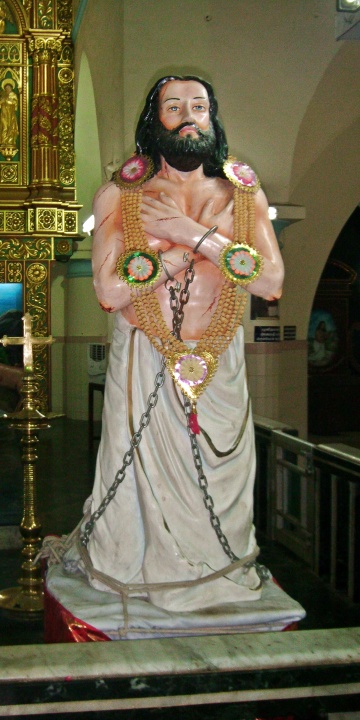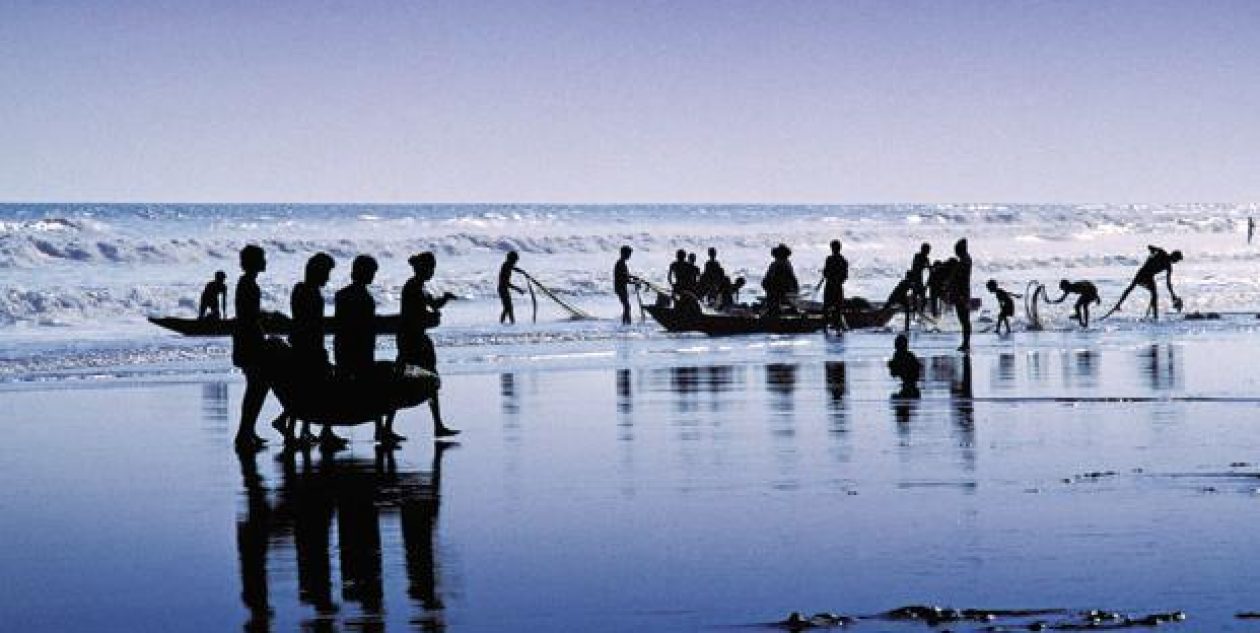

In the Vatican, during the impressive canonization ceremony held in St. Peter’s Basilica today, Sunday, May 15, 2022, His Holiness Pope Francis canonized Blessed Devasahayam Pillai, along with nine others. The choir made Tamil proud by singing “Tamil Thai Vaazhthu” (Praise to Mother Tamil).
Devasahayam Pillai, embraced Christianity in the 18th century and is considered a martyr. He is the first Indian layman to be declared a saint.
Devasahayam Pillai (April 23, 1712 – January 14, 1752) was born as Neelakanta Pillai into an affluent Pillai-caste Hindu family at Nattalam in the present-day Kanyakumari District, then belonging to the Kingdom of Travancore.
Neelakanta Pillai’s father, Vasudevan Namboodiri, hails from Kayamkulam, in present-day Kerala state. He was a priest at the Adikesava Perumal Temple in Thiruvattar, in present-day Kanyakumari district of Tamil Nadu. His mother, Devaki Amma, hails from Thiruvattar in Kanyakumari District. In the Nair matrilineal traditions of the day, his maternal uncle raised him and inculcated him with Hindu beliefs and traditions.
The family of Vasudevan Namboodiri had much influence in the royal palace of Maharaja Marthanda Varma, King of Travancore. So, young Neelakanta Pillai went into the service of the royal palace. Ramayyan Dalawa, the Dewan of Travancore, noticed the capabilities and enthusiasm of the young man and appointed him as an official in charge of state affairs.
Captain Eustachius De Lannoy
In 1741, the Dutch East India Company sent naval commander Captain Eustachius De Lannoy to capture and establish a trading port at Colachel in Travancore. In the ensuing “Battle of Colachel”, the Dutch forces were defeated. De Lannoy, his assistant Donadi, and some Dutchmen surrendered.
The king of Travancore pardoned De Lannoy and the Dutchmen , on condition that they serve in the Travancore army.
In the course of time, earning the trust of the king, De Lannoy became the commander of the Travancore armed forces. He trained the Travancore forces on European lines. He introduced new weaponry and gun-powder. He won many battles for Travancore and annexed many neighbouring kingdoms and territories to Travancore.
Conversion to Christianity
When Neelakanta Pillai was 29 years old, he got acquainted with Captain Eustachius De Lannoy. The latter’s Christian faith interested the former. De Lannoy enlightened Neelakanta Pillai on the Christian faith.
In 1745, Neelakanta Pillai got baptized at the Roman Catholic sub parish church at Vadakkankulam village (in the present-day Tirunelveli District of Tamil Nadu), where the Jesuits had a mission under Rev. Fr. R Bouttari Italus SJ. He assumed the name Devasahayam, which is the Christian name ‘Lazarus’ in the local language. “Lazarus” or “Devasahayam” in Malayalam, translates to “God is my help.”.
Devasahaym’s wife, Bhargavi Ammaal hailed from Kunchu Veedu, Elanthavilai, Mayicode in Travancore State. She, too, got baptized alongside her husband. She assumed the baptismal name “Gnanapoo Ammaal” (“Flower of Knowledge,” equal to Theresa in Tamil and Malayalam). Later on, some other members of Devasahayam Pillai’s immediate family also received baptism.
Fearing reprisal in her native village in Travancore against her religious conversion, she became a migrant-resident of Vadakkankulam village.
Accusations and charges
Devasahayam Pillai insisted on the equality of all people, despite caste differences. This infuriated the higher classes. The Brahmin Chief Priest of the kingdom, a few feudal lords, some members of the royal household, and the Nair community brought false charges against Devasahayam Pillai. They alleged that he, by using his powerful official position and the state funds, was orchestrating conversions of Hindus to Christianity. He was also accused of treason for divulging state secrets to Europeans because they were his coreligionists. Also, documents dating back to the period encompassing Pillai’s lifetime show that the religious conversion of court officials to Christianity was not tolerated. The Dewan, Ramayyan Dalawa arrested Devasahyam Pillai and divested him of his portfolio in the Travancore administration.
The authorities treated Devasahayam Pillai like a criminal. As advocated by the royal ministers, ten different karyakkars (Royal officers) tortured him. They beat him every day with eighty stripes.; rubbed pepper on his wounds and nostrils; made him stand in the sun, and gave him only stagnant water to drink.
Devasahyam Pillai remained in prison for three years, during which time the king of Travancore came under tremendous pressure from the Europeans who sought his release. Finally, in 1792, royal orders declared his banishment from the Kingdom of Travancore.
The authorities made him sit backward on a water buffalo (the mythical vehicle or vahana of Yama, the lord of death in Hinduism) . They marched him from the Padmanabhapuram Palace to Aralvaimozhy over a period of a few days.
According to the royal order, he was to undergo a public humiliation. As was customary in those days for criminals, they painted his body with red and black spots. They made him sit backward on a water buffalo (the mythical vehicle or vahana of Yama, the lord of death in Hinduism).
They marched him from Padmanabhapuram Palace to Aralvaimozhy. On the way, they halted at Puliyoorkurichi about 15 km from Nagercoil. There, Devasahayam kneeled before a rock to pray. The Christians believe that God quenched his thirst by letting water gush through a small hole in the rock. The water hole is still found in the compound of St. Martyr Devasahayam Pillai Church, at Puliyoorkurichi.
On reaching Aralvaimozhy, the authorities released him into a mountainous forest area, on the other side of which was the kingdom of the Pandya kings, the traditional rivals of Travancore.
Death
After his release, Devasahayam started meditating. People from the nearby villages started visiting the holy man. This infuriated high caste Hindus, who plotted to kill him.
On January 14, 1752, soldiers from the Travancore kingdom tried to shoot Devasahayam but were unable to fire their guns. Devasahayam then took a gun from one of the soldiers. He blessed it, gave it back to him, and asked the soldiers to shoot him to death if they wished to do so. The soldiers then fired at him five times and threw his dead body near the foothills at Kattadimalai. Devasahayam Pillai thus received the crown of martyrdom.
Some people in the region recovered Devasahayam’s body and carried it to St. Francis Xavier’s Church (now the diocesan cathedral) at Kottar, Nagercoil, and interred his mortal remains near the altar. From that day on, many Christian pilgrims have visited his tomb and offered prayers.
The followers of Martyr Devasahyam Pillai, have preserved his clothes and other belongings at the Holy Family Church, built in 1779, in the small town of Vadakkankulam in Tirunelveli District of Tamil Nadu State, India. Kept in a glass case, these relics are exposed on August 15 every year, during the feast of the Assumption of Mary. His wife, Gnanapoo Ammaal is buried in the cemetery there.
RELATED ARTICLES
- Devasahayam Pillai (en.wikipedia.org)
- Devasahayam Pillai’s canonisation feted by Latin Catholic churches in Kerala, Tamil Nadu (theprint.in)
- Devasahayam Pillai becomes 1st Indian layman to be declared saint by Pope (timesofindia.indiatimes.com)
- Devasahayam Pillai: All you need to know about first Indian layman to be declared saint by the Pope (livemint.com)
- Devasahayam Pillai’s martyrdom spot Kattadimala aka Devasahayam Mount: Here’s what visitors should know (onmanorama.com)


















